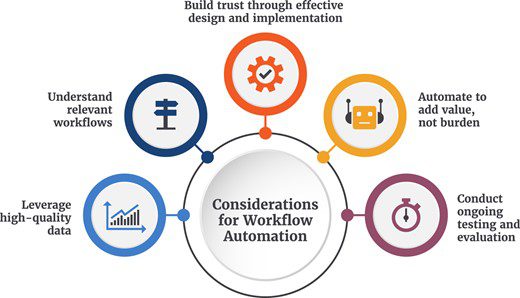
Healthcare workflow automation involves identifying sequences of tasks that can be streamlined using technology, offering an incredible opportunity to address efficiency challenges. Other industries have successfully implemented automation to address workflow concerns, and lessons learned can inform its application in healthcare.
In this article, we’ll explore key considerations and priorities for advancing workflow automation in healthcare based on recent research by the Office of the National Coordinator for Health Information Technology (ONC).
Considerations for Workflow Automation
Before implementation, you must understand the facilitators and barriers to adopting workflow automation. Doing so helps to identify where opportunities for process automation exist within your health system, which processes best qualify, and how you can maximize results with limited resources.
Through their research, the ONC identified the following considerations:
- Leveraging high-quality data
- Understanding relevant workflows
- Building trust through effective design and implementation
- Automating to add value, not burden
- Conducting ongoing testing and evaluation
We recommend reviewing each of these considerations carefully with a trusted technology partner. This level of due diligence requires careful planning but is a critical first step in achieving automation success.
Priorities for Advancing Workflow Automation in Healthcare
By focusing on these six automation priorities, health systems will be well positioned to get the greatest ROI, with the least disruption and risk.
Priority 1: Mobilize nationwide scalable automation in near-term “sprints” and long-term “marathons”
To build buy-in, workflow automation must be approached in iterative phases with the long-term goal of a fully automated process. Roll outs should be thoughtful, with adequate support and training. Prioritize interoperable technologies that can easily integrate into different systems and can be scaled up as the solution gains traction. When streamlining transitions of care workflows, Strata Health US offers an integrated platform with multiple products. The products work seamlessly together, but they can also be deployed individually depending on the health system’s needs.
Priority 2: Enable discovery of redundant tasks
To scale automation initiatives, you must be willing to create and promote a culture of innovation that encourages critical thinking, analysis, and continuous improvement. Just because something has always been done a certain way, doesn’t mean it’s the best way. We can look at the burden of the fax machine as an example. In the not-so-distant past, fax was the primary way of communicating across health systems, despite the technology’s many well-known flaws. The grassroots effort to Axe the Fax only gained traction and became a global phenomenon because someone dared to say, “enough is enough. There must be a better way!”
Priority 3: Ensure a ready clinician base for workflow automation
Give clinicians the support they need to embrace automation, not fear it. Present a compelling case for why their work will improve if they adopt the change. Help them understand how automation will relieve workflow burdens, save time, reduce frustrations, and empower them to operate at the top of their license. Taking a personalized approach that answers the question, “What’s in it for me?” can help reduce change resistance.
Priority 4: Enable all stakeholders to effectively and efficiently engage in health and healthcare tasks
An effective automation solution must reduce redundancy and administrative burdens for clinicians, patients, and caregivers so that the focus can be on what matters most: delivering high quality-care without delay. The last thing you want to do is introduce a new solution that gets in the way instead of aiding the work of health professionals.
Priority 5: Improve patient and caregiver interactions with health and healthcare
Given the complexities of coordinating services across health systems, your automation solution must enable seamless communication and information sharing between patients, providers and other stakeholders. By automating high-volume, repetitive tasks that clinicians grapple with daily, health systems can save time and valuable resources, while improving patient and care management experiences.
Priority 6: Leverage interoperable health data for automation
Health systems are comprised of several organizations that use varying technologies and systems. Therefore, data must be shared easily across disparate technologies to drive efficiencies and improve the likelihood of scaling automation initiatives.


Automate Transition of Care Workflows with Strata Health
At Strata Health, we are experts in workflow automation. The transition of care process from hospital to post-acute care involves a number of repetitive, time-consuming tasks that are prime for automation.
- Strata Search automates patient choice for post-acute care
- Strata Sign enables electronic signatures on digital case management forms with automated posting to the EHR
- Strata Send streamlines the entire transition of care workflow, with automated alerts, communication, and information sharing between clinicians and providers
Over 480 hospitals use Strata Health’s integrated platform to create efficiencies, improve patient engagement, and drive better outcomes. Contact us today to learn about our customizable solutions. Together, we’ll find the strategic approach that’s right for you.
